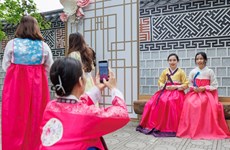Vua pagoda – Hanoi’s legendary Chinese-chess site
Located on Thinh Yen street , Vua pagoda has been regarded as a meeting place
for Chinese-chess players for centuries.
Located on Thinh Yen street , Vua pagoda has been regarded as a meeting place
for Chinese-chess players for centuries.
The pagoda itself was built in the Ly dynasty (1099-1225). But it was in the early Le dynasty (1428-1527) that a prince built a shrine to De Thich, who is said to be the master of Chinese-chess, near the pagoda and used the site as a playing field for Chinese-chess in Thang Long, now Hanoi .
Since then, the pagoda has become Hanoi ’s most famous spot for players to gather. Each year, they come to the pagoda from across the country to pay homage to De Thich and challenge each other at their favourite game. Many Chinese-chess players from China , Laos and Cambodia also trek here for competitions in which the winners are presented a valuable set of chess pieces. And those players who win the games for three consecutive years will have their names carved on a stone stele near the playing field.
Nguyen Tan Tho, 80 years old, a veteran Chinese-chess player, said that the sport can be played in various forms, even using people, lanterns or signposts as chess-pieces.
Expertise at the game is said to demonstrate the character and intelligence of players and help them develop a forward-looking vision, patience and carefulness. In addition, the sport represents the traditional Asian viewpoint of using intelligence, not force, to win.
Nguyen Vu Quan, after participating in competitions at the pagoda, has become the Chinese chess champion in Vietnam three years in a row--2007, 2008 and 2009.
Chinese-chess playing is a part of Hanoi ’s culture, and visitors can also enjoy the sight of young and old people engaged in spirited matches at the chessboard while strolling around the Hoan Kiem Lake in the late afternoon./.
The pagoda itself was built in the Ly dynasty (1099-1225). But it was in the early Le dynasty (1428-1527) that a prince built a shrine to De Thich, who is said to be the master of Chinese-chess, near the pagoda and used the site as a playing field for Chinese-chess in Thang Long, now Hanoi .
Since then, the pagoda has become Hanoi ’s most famous spot for players to gather. Each year, they come to the pagoda from across the country to pay homage to De Thich and challenge each other at their favourite game. Many Chinese-chess players from China , Laos and Cambodia also trek here for competitions in which the winners are presented a valuable set of chess pieces. And those players who win the games for three consecutive years will have their names carved on a stone stele near the playing field.
Nguyen Tan Tho, 80 years old, a veteran Chinese-chess player, said that the sport can be played in various forms, even using people, lanterns or signposts as chess-pieces.
Expertise at the game is said to demonstrate the character and intelligence of players and help them develop a forward-looking vision, patience and carefulness. In addition, the sport represents the traditional Asian viewpoint of using intelligence, not force, to win.
Nguyen Vu Quan, after participating in competitions at the pagoda, has become the Chinese chess champion in Vietnam three years in a row--2007, 2008 and 2009.
Chinese-chess playing is a part of Hanoi ’s culture, and visitors can also enjoy the sight of young and old people engaged in spirited matches at the chessboard while strolling around the Hoan Kiem Lake in the late afternoon./.













